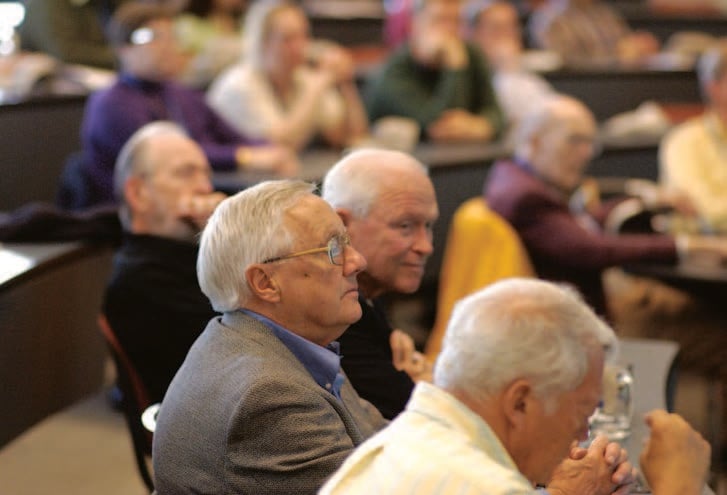
“Our goal,” said Peter Searson, director of Johns Hopkins’ Institute for NanoBioTechnology (INBT), “is to establish Hopkins as the world leader in nanobiotechnology. Or, as I like to say, world domination.” The 40 or so alumni gathered in Hodson Hall appreciated Searson’s humor, especially at the beginning of an intensive, hourlong lecture on the characteristics of the very tiny things the INBT faculty researches.
Searson, who helped launch the INBT in 2006, was one of two Whiting School professors who hosted Alumni College during the Johns Hopkins Homecoming and Reunion in April. He and civil engineering professor Tony Dalrymple, who spoke on “Natural Hazards: Lessons Learned from the Tsunami and the Hurricane,” led independent sessions open to all alumni, during which they explained their research and the latest developments in their fields.
Mac McLeod ’57 and his wife, Lenore Danielson, who were visiting from their home in New Jersey, attended Searson’s morning lecture. “Professor Searson is one of the best lecturers I’ve heard,” McLeod commented. “It’s a fascinating field and he’s a fascinating teacher. It makes you feel like you’d like to go back to school and be in his class. It leaves you with a lot to think about, and it’s amazing to learn that the cost of solving the problems they’re working on is so high.” His wife interjected, “And to realize that the cost of not solving them is equally high.”

Searson’s presentation began with talk of size and scale. He explained that a “buckey ball”—a fundamental building component in the world of nanobiotechnology—is only a nanometer wide. By comparison, a single strand of a human hair is 100,000 nanometers wide. “We can make materials that are smaller than cells, which means that we can build things that can go into cells and deliver drugs,” he noted. He went on to discuss how nanobiotechnology engineers and scientists are searching for new therapies, new diagnostic tools, and a better understanding of the relationship between cells and disease.
While alumni from ages 30 to 90 listened intently, Searson continued on to explain the logistics of shrinking things to the nano scale, such as the discovery that when something gets smaller, a higher percentage of its atoms are on the surface. The result? Everything from fibers for athletic clothing that “wick away” liquid to drug delivery systems that target cancer cells.
Searson’s lecture ended with projections for what the future of nanobiotechnology holds in store for the world. “We will be able to take a ‘smart pill’ that will be programmed to report on its position and status in the body before releasing the correct dose of drugs,” he predicted.
Searson believes Johns Hopkins will be at the forefront of such discoveries, and he predicts we will see this technology hit the marketplace within decades.




